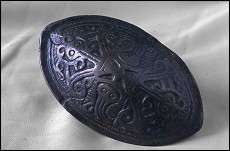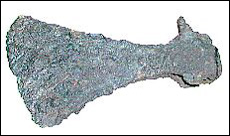
|
Graves at the Kauskila burial ground. Picture, South Karelian Museum / Ville Laakso.
|

|
|
Silver cross pendant from c. 1200s, found at the Kauskila burial ground. The object originates in eastern church circles. The burial ground was used from the 1100s to the 1500s. Picture, South Karelian Museum.
|
The Time of the Crusades
In addition to the coastal inhabitants and the people of Häme, there were also others who turned their gaze towards the interior of the country. While the Crusades were underway, the Swedish and Novgorod empires that had formed around Finland wanted to extend their domain as widely as possible. At the same time, the western and eastern churches were battling over the region's pagan tribes. During the Crusades period, a unique Karelian culture evolved in the Käkisalmi area, centering around Lake Ladoga's western and northwestern shores. From there the population spread to the areas around Mikkeli, Lappeenranta, northern Ostrobothnia, northern Karelia and Viena Karelia.
The Kauskila burial ground at Lappeenranta, dating to the time of the Crusades and the early Middle Ages, is considered Karelian on the basis of the objects buried with the deceased, but the artefacts also tell of Swedish and Baltic influences. In addition to Kauskila, Karelian-style items from the time of the Crusades have been found at Myllymäki and Annikkala in Lappeenranta, Myttylä in Ylämaa, and at the Vammonniemi and Mammonniemi burial grounds in Taipalsaari.

|

|
|
Oval tortoise brooch of bronze, found at the Kauskila burial ground. Oval clasps were used to fasten a woman's outfit at the shoulders and also to carry a heavy jewellery arrangement. Large oval brooches with acanthus-pattern ornamentation were used in Karelian areas at the time of the Crusades. Picture, South Karelian Museum / Seppo Pelkonen.
|
Article belonging to a woman's jewellery ensemble; it has been called an ear spoon. Its shape led to the conclusion that this may have been used for personal hygiene such as ear cleaning. Picture, South Karelian Museum / Seppo Pelkonen.
|

|

|
|
Silver Swedish coins with ornamentation, from a grave at Kauskila. The coins date from 1300-1325. Picture, South Karelian Museum.
|
An axe from a man's grave in the Kauskila burial ground. Picture, South Karelian Museum.
|
